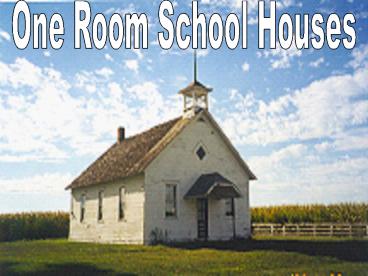One Room School Houses PowerPoint PPT Presentation
1 / 11
Title: One Room School Houses
1
One Room School Houses
2
A day in a one- room schoolhouse encompassed a
wide range of events. The teacher was expected to
arrive at the schoolhouse about an hour before
the students. She was to draw water from the
well, have lit a fire to warm the building, and
often raised the flag. Typically, at 800 am the
school bell was rung.
Whispering Pines School
3
Upper Maple Hill School
One-room schoolhouses mixed together a wide
variety of students. Many students fondly
remember the experience as creating a strong
sense of community. The word "family" frequently
appears in subsequent reminisces by those who
attended one room schools.
4
Rural school teachers enjoyed neither vacation
nor sick time. After state laws mandated a
specific number of school days to be taught,
rural teachers made up any absences by teaching
extra days at the end of the school year. Rose
Hamlin Tennis, who taught in various one-room
schools in the mid-Michigan area, recalled how an
appendicitis operation in mid-year closed school
for several days which were made up in June.
Jerusalem Hill School
5
Although simple buildings, one-room school houses
developed a distinctive architectural appearance.
Almost invariably the first "school house" in a
rural district consisted of a log cabin. The log
cabin schools, while minimally functional, really
were not very well adopted to the needs of the
students or teachers. As time passed new school
buildings became similar to houses in their
construction.
Liberty Hill School
6
Despite the sometimes difficult circumstances
faced by students, many realized that their one-
room school was a ladder of opportunity to what
they saw as a better life. The opportunities
afforded students could be measured both in terms
of future job prospects and their future
lifestyle.
South Hollow School
7
West Hill School
During the day each class was called to the
"recitation" bench. There the teacher worked
exclusively with those children for a period,
while the other students busied themselves
studying or doing an assigned lesson. Normally
there was a brief morning recess of about fifteen
minutes, followed by more classes, and then an
hour for lunch. The afternoon was spent much like
the morning with classes and a short recess.
During the hour of afternoon recess, the younger
students, would be dismissed for the day. The
last hours of the school day was spent by the
teacher working with the more advanced fourth
through eighth graders.
8
Marriage was seen as a critical event that many
local school boards tried to discourage until the
end of the academic year. Many school boards
required teachers to sign a contract granting the
board authority to discharge a female teacher who
married during the school year. Some contracts
regulated the teacher's social life, required
that she be at home by 800 p.m. unless later
hours were explicitly approved by the school
board and forbidding her from attending social
functions other than those sponsored by the
school itself or a church.
Upper Hill School
9
Lower Bingo School
In the 1930's the federal government used Work
Projects Administration funds to make
improvements in all "standard" one-room schools.
These improvements included the installation of a
furnace to replace room heaters, inside chemical
toilets to replace those outhouses that remained,
and windows on at least one wall of the building,
usually situated so that the light would come in
over the students left shoulders. The WPA
standards of the 1930's remained more or less the
standard for one-room school houses.
10
WORKS CITED
- http//www.ratrun.com/one_room_school_houses.htm
- http//www.colusi.org/linked/html/school_houses.ht
m - http//www.edu.pe.ca/vrcs/studentwork/2001/gr8/gen
erations/ANDRE/SCHOOL.HTM - http//www.lib.cmich.edu/clarke/schoolsintro.htm
11
THE END

